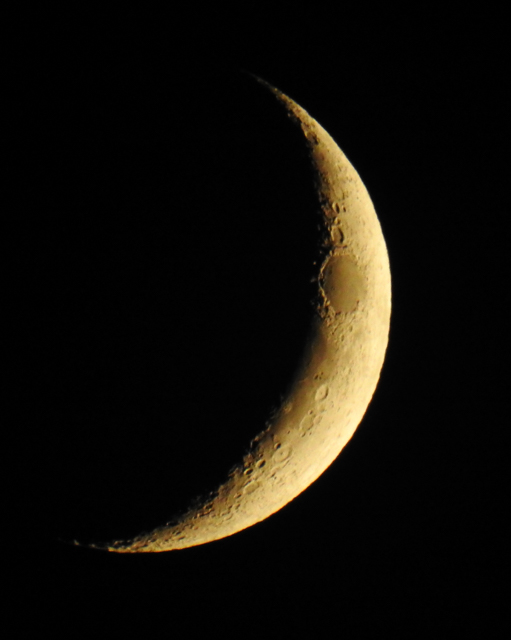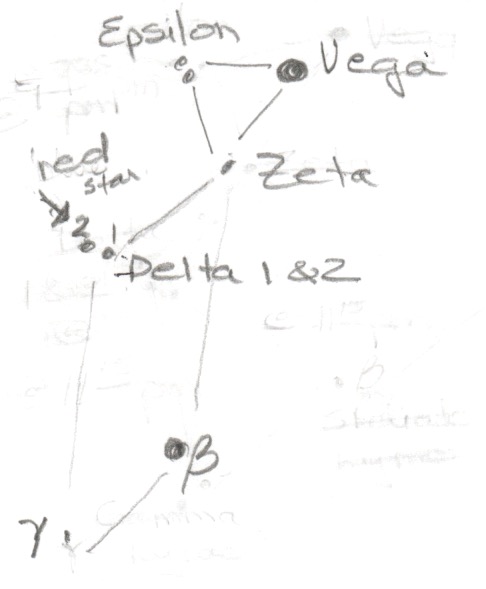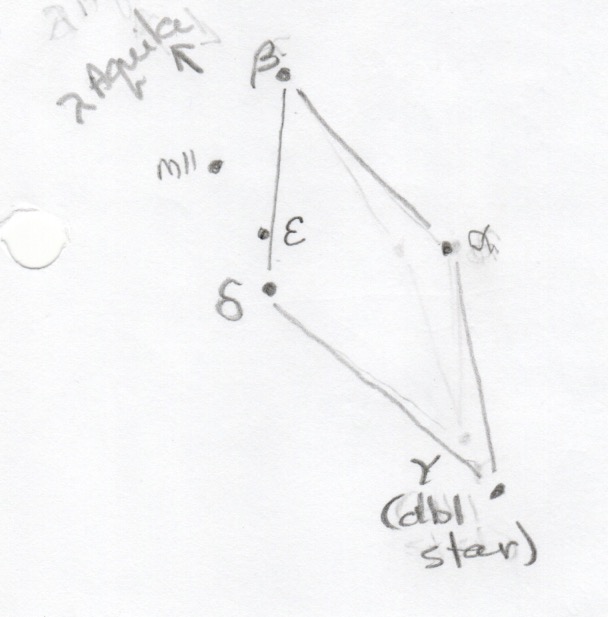
Coolpix P900, ISO 800, 1/100 sec @ f/6.5 |
Part of this session was devoted to observing the Waxing Crescent Moon (14.6%). Refer to Explore the Moon (Binocular) - July 26, 2017. Constellation: Capricornus, Cassiopeia, Libra, Lyra, Scorpius, Scutum, Ursa Major |
Location: SCO
Date: 2017-07-26/27
Time: 9:10 PM - 2:00 AM
Instrument: Visual + Binoculars 10x30 IS
Magnification: x10
Transparency: Excellent (5)
Seeing: Excellent (5)
Temperature: 10º C
No wind or cloud.
I also attempted to find M17 and M18 but could not locate them with my binoculars.
 |
Jupiter |
 |
Lyra |
Scorpius
Time: 9:40PM - 10:15 PM
Instrument: Visual
S&T Chart Reference: 56, 58, J
The second experiment of the evening. Wanted to see when the stars of Scorpius would become visible in the southern horizon (or at least when I noticed they became visible).
9:40 PM: Antares
9:48 PM: ν, Graffias
9:54 PM: π, ρ
10:12 PM: The stars below Antares in the constellation were visible above the tree line. Perhaps θ or η were faint or below the trees.
|
Cassiopeia Saturn |
Ursa Major Time: 9:50 PM + 10:37 PM Instrument: Visual + Binoculars 10x30 IS S&T Chart Reference: 31, 32, 33, 43, F I visually identified all the stars within Ursa Major, not just the Big Dipper asterism. I later used my binoculars to look at the optical double in the handle - Mizar and Alcor. |
|
Satellite (ISS) |
Satellite Time: 10:35 PM - 10:36 PM Instrument: Binoculars 10x30 IS Sighting was accidental. Looking at Antares with my binoculars when it entered my FOV. It disappeared near Spica. |
|
M7 (Ptolemy's Cluster) |
|
|
M22 |
M28 Time: 10:57 PM Instrument: Visual + Binoculars 10x30 IS Using Kaus Borealis visually and finding M22, I put the eyepiece back on the lid star in the lower left and M28 was readily seen as a round smudge. It had what appeared to be a brighter/denser centre. Couldn't discern any stars in the cluster with my binoculars. |
|
Scutum |
 |
|
M8 (Lagoon Nebula) |
M11 (Wild Duck Cluster) Time: unknown Instrument: Visual + Binoculars 10x30 IS S&T Chart Reference: 67 I looked for the semi-circle of stars above the Teapot. Using my binoculars, I easily located the 'golf club' and 'golf ball' (aka M11). |
|
M20 (Trifid Nebula) |
M21 Time: unknown Instrument: Visual + Binoculars 10x30 IS S&T Chart Reference: 67, 69, I After finding M20 a few moments earlier, I went up a partial FOV at about 45º to M20 to see M21 very clearly in my binoculars. |
Meteor
Time: 11:09 PM
Instrument: Visual
It ran parallel to 2º - 5º below the line from Ascella to Kaus Borealis in the Teapot.
| Libra Time: 11:29 PM Instrument: Visual + Binoculars 10x30 IS S&T Chart Reference: 46, 57 Libra was very low in the sky but I was able to see α Libra (Zubenelgenubi). The brightness of this star alerted me this constellation was now visible. I put my binoculars up to this star and had a long look at it to discover this was a double star - α1 and α2. Alpha1 was a bright yellow star and about twice the size of its companion. Alpha2 was a bluish star, fainter and seemed to be twinkling at times. I didn't look for the other stars in this constellation. |
Capricornus Time: 11:56 PM Instrument: Visual + Binoculars 10x30 IS S&T Chart Reference: 66, 68, 77 I moved to the far end of the gravel pads next to the trees in the west. Given Scorpius and Sagittarius had moved towards the west, I hoped to locate this constellation - and I did. Most of the stars could be located except ζ and ε that were hidden by a tree. After finding the constellation visually, I used my binoculars to look at α Cap1 and α Cap2 (Algedi) and had no difficulty doing so. |
NGC 7000 / North America Nebula
Time: 12:25 AM - 12:45 AM EDT
Instrument: Visual + Binoculars 10x30 IS
S&T Chart Reference: 62, 73
Art Cole was at SCO tonight and pointed out NGC 7000. He pointed to Deneb in Cygnus and said it was just below it, that it looked like North America, including the Gulf of Mexico.
I used my binoculars and sat in the gravity chair in my attempt to find it. For the life of me, I couldn't find the dark Gulf to identify the nebula, even after 20 minutes of searching. However, maybe because of a strong desire to locate/see it, or because of my imagination, I thought I could faintly see it visually. Need another clear night to attempt again.
Kemble's Cascade
Time: 12:41 AM
Instrument: Visual + Binoculars 10x30 IS
S&T Chart Reference: 11, 13
Now that Cassiopeia was higher in the sky and away from the trees, I was easily able to visually determine where Kemble's Cascade was located and then to see it with my binoculars, including the hockey stick ending.
How to find Kemble's Cascade:
Place digit #1 (e.g., your left thumb) on Caph and digit #2 (e.g., your left baby finger) on Segin. Holding your fingers in that position and following the line/direction formed by Caph-Segin, move digit #1 on Caph to Segin so that digit #2 is away from Cassiopeia. The top of the Cascade should now be where your baby finger is located in Cameliopadardalis. Look for the hockey stick ending!